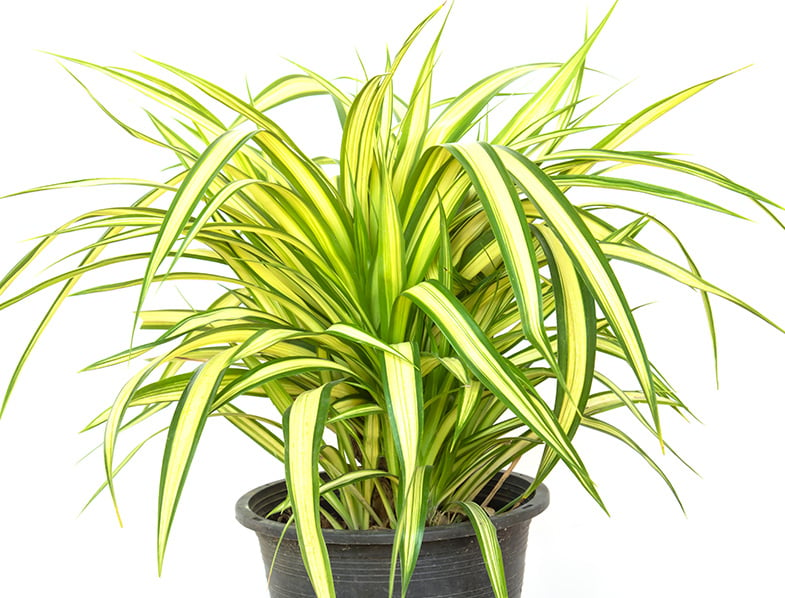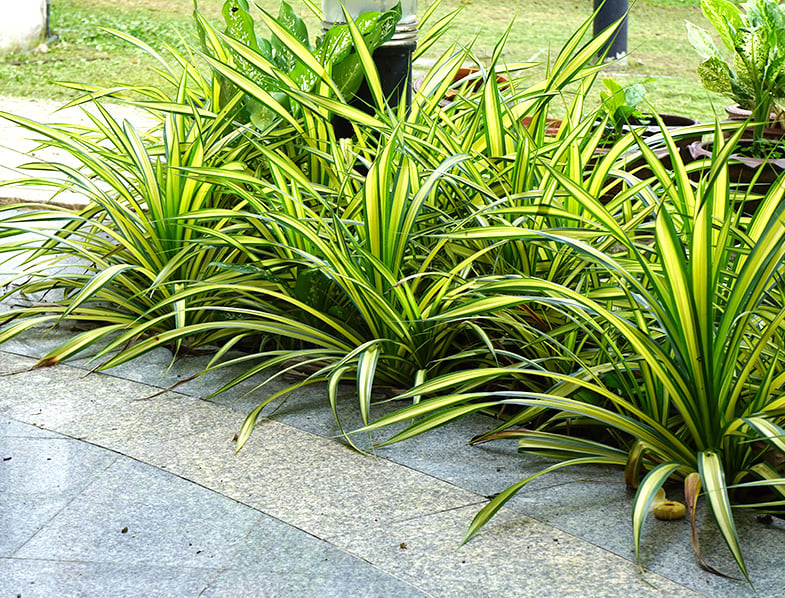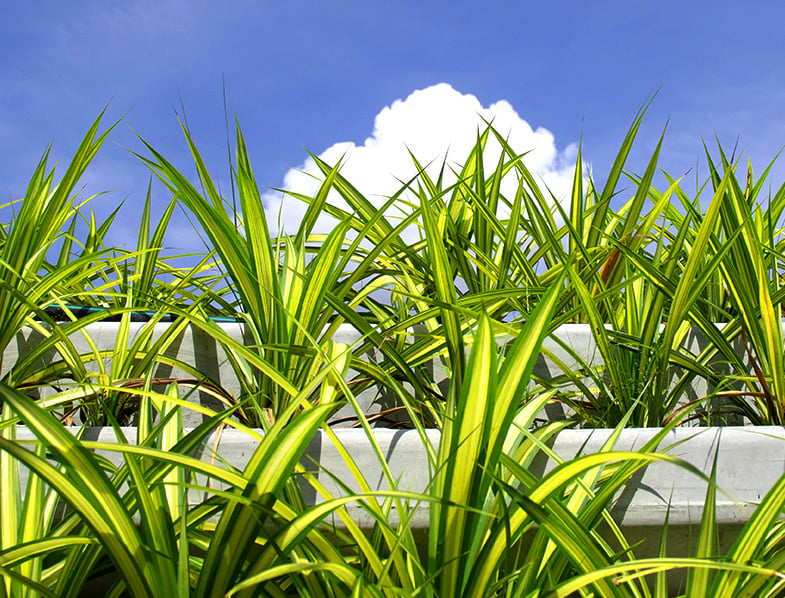Variegated Screw Pine plants live a long time and are great tropical plants to add to any home or office. This plant thrives in bright spaces, be it natural light or bright florescent lighting. This fast-growing plant prefers larger spaces over smaller rooms.
A mature Pandanus veitchii plant will produce leaves that are three feet long, so make sure to choose your location wisely when adding this green gem to your indoor collection. Keep in mind that the edges of mature Pandanus veitchii plants have spikes, so place them where people won’t brush up against the fronds easily.
Screw pines are native to seaside habitats, as a result; all of these plants eventually develop aerial roots. These types of roots help to anchor the plant in the soil and keep them from being uprooted in strong winds. Though indoor plants don’t have to contend with seaside winds, the plant still will develop them. You can simply tuck them into the sides of whatever pot is housing your plant.
This is also a tropical plant that needs humidity or else the leaves will wither and turn brown. Its leaves are usually variegated which adds to its allure and makes it a popular choice among homeowners.
Although the Pandanus Veitchii is called a pine, it is not really a true pine. The leaves of this curious plant look sort of like a pineapple, which is where the name screw pine originated.
The outward arching leaves of this spiky plant are one if its most attractive features. The leaves have a tight spiral that is complimented by hooked spines on the side of each leaf. As attractive as they look, they are painful to touch or brush against so keep that in mind when choosing your placement.
Quick Facts
| Plant Name | Variegated Screw Pine, Pandanus Veitchii |
|---|---|
| Lifespan | Up to 15 years |
| Origin | Pacific Islands, Southeast Asia |
| Indoor Height | Up to 5 feet |
| Light Requirement | Bright natural or indoor light |
| Watering | Moderate, less in winter |
| Humidity | Around 50% |
| Propagation | Offshoots or ‘pups’ |
| Pest Susceptibility | Prone to winter spider mite infestations |
| Special Features | Green and yellow variegated leaves, sharp spines, aerial roots |
| Ideal Temperature Range | 65 to 80 degrees Fahrenheit |
About the Screw Pine
- The botanical name of the screw pine is Pandanus Veitchii.
- Variegated Screw Pine is a long-lived plant that often survives for decades.
- Screw Pine originates from the Pacific Islands and Southeast Asia.
- They typically grow as tall as five feet when cultivated indoors.
- The screw plant is a tropical plant that loves bright places.
- Pandanus veitchii plants are fast-growing and need ample space to expand.
- Screw pine plants grow quickly in all seasons.
Screw Pine Features: An Overview
- The leaves of the Pandanus veitchii are green and yellow in color.
- The fronds of the screw plant spiral upwards from the trunk.
- The edges of the screw pine have sharp spines.
- Aerial roots are common in indoor and wild screw pines.
- The screw pine plant is a native of Polynesia.
- Lack of proper sunlight will cause the leaves to lose their variegation.
- The average lifespan of a screw pine is 15 years.

Growing The Screw Pine
Growing the Pandanus veitchii is easy. It has a moderate growth rate and will need to be moved into a larger pot each spring. A pot that is about two inches larger than last year’s pot is generally sufficient.
The screw pine doesn’t have to worry about most pests, however, it is prone to winter spider mite infestations. These mites love the dry winter air and will suck the sap from the leaves. This will result in spots on the leaves as well as curled tips.
The Pandanus veitchii thrives in bright light. If your plant leaves are fully green, it means that your plant is not getting adequate sunlight. Place the plant outside during the summer, but make sure it is in a shaded area at midday. They do well with a moderate amount of water during the growing season and slightly less during the cooler winter months with growth is dormant.
The screw pine thrives in temperatures that range from 65 degrees to 80 degrees, but they should be kept away from ac vents and drafts. Using a high-quality potting soil with a generous amount of horticultural sand mixed in will ensure proper drainage. Make sure to also feed the plant a balanced water-soluble fertilizer every other week during the growing season, but avoid fertilizing in the winter.
- VERSATILE LIVE HERB PLANT: The Pandanus amaryllifolius, a live herb plant that thrives both indoors and outdoors. Enjoy the convenience of having fresh pandan leaves within arm's reach for culinary delights and aromatic infusions. This plant is suitable for Zones 9-11
- OUTDOOR AND INDOOR DELIGHT: This live plant is an excellent addition to your outdoor garden or indoor space. Its lush green foliage brings a touch of nature's beauty to any setting, making it a versatile choice for herb enthusiasts.
- IDEAL FOR VEGETABLE GARDENS: Enhance your vegetable patch with the Pandanus amaryllifolius. This live plant complements your vegetable plants, contributing to a vibrant and diverse garden.
- COMPACT SIZE, ABUNDANT POTENTIAL: Ranging from 3-8 inches tall, this live plant arrives in a 3-inch-deep pot. Despite its small size, it holds the promise of providing ample pandan leaves, ensuring you have a steady supply for your culinary creations.
- OUTDOOR RESILIENCE: The Pandanus amaryllifolius thrives as an outdoor plant, adapting to various environmental conditions. Its resilience allows it to flourish amidst other trees, adding an elegant touch to your outdoor landscape or garden.
- Elevate your indoor oasis with the enchanting allure of the Pandan Plant. Originating from Southeast Asia, this tropical gem is a striking addition to any plant lover's collection. With its vibrant, elongated leaves in hues ranging from deep green to mesmerizing shades of chartreuse, the Pandan Plant adds an exotic touch that turns your living space into a verdant paradise.
- Embrace the joy of hassle-free gardening with the Pandan Plant. Renowned for its low maintenance and adaptability, this resilient houseplant thrives in a variety of indoor environments. From bright, indirect light to partial shade, the Pandan Plant gracefully flourishes, making it an ideal choice for both seasoned plant enthusiasts and beginners alike.
- Unleash your culinary creativity with the Pandan Plant's versatile leaves. Widely used in Southeast Asian cuisine, these fragrant leaves add a unique flavor profile to a variety of dishes, from savory to sweet. Imagine infusing your favorite rice dishes, desserts, and beverages with the distinctive essence of pandan—transforming everyday meals into extraordinary culinary experiences.
- Beyond its aesthetic appeal, the Pandan Plant doubles as a natural air purifier, enhancing the quality of your indoor environment. This eco-friendly companion effortlessly filters out common pollutants, promoting a healthier atmosphere in your home. Breathe easy as the Pandan Plant works its magic, contributing to a sense of well-being and harmony.
- Looking for the perfect gift for a plant enthusiast or someone who appreciates the finer things in life? The Pandan Plant is a thoughtful and distinctive choice that embodies the beauty of nature. Whether it's for a housewarming, birthday, or any special occasion, this living gift adds a touch of elegance and a dash of the exotic to any celebration.
- Elevate your indoor oasis with the enchanting allure of the Pandan Plant. Originating from Southeast Asia, this tropical gem is a striking addition to any plant lover's collection. With its vibrant, elongated leaves in hues ranging from deep green to mesmerizing shades of chartreuse, the Pandan Plant adds an exotic touch that turns your living space into a verdant paradise.
- Embrace the joy of hassle-free gardening with the Pandan Plant. Renowned for its low maintenance and adaptability, this resilient houseplant thrives in a variety of indoor environments. From bright, indirect light to partial shade, the Pandan Plant gracefully flourishes, making it an ideal choice for both seasoned plant enthusiasts and beginners alike.
- Unleash your culinary creativity with the Pandan Plant's versatile leaves. Widely used in Southeast Asian cuisine, these fragrant leaves add a unique flavor profile to a variety of dishes, from savory to sweet. Imagine infusing your favorite rice dishes, desserts, and beverages with the distinctive essence of pandan—transforming everyday meals into extraordinary culinary experiences.
- Beyond its aesthetic appeal, the Pandan Plant doubles as a natural air purifier, enhancing the quality of your indoor environment. This eco-friendly companion effortlessly filters out common pollutants, promoting a healthier atmosphere in your home. Breathe easy as the Pandan Plant works its magic, contributing to a sense of well-being and harmony.
- Looking for the perfect gift for a plant enthusiast or someone who appreciates the finer things in life? The Pandan Plant is a thoughtful and distinctive choice that embodies the beauty of nature. Whether it's for a housewarming, birthday, or any special occasion, this living gift adds a touch of elegance and a dash of the exotic to any celebration.
Last update on 2024-09-20 / Affiliate links / Images from Amazon Product Advertising API
Watering The Screw Pine
Watering the Pandanus veitchii is not complicated. You should make sure that the roots are moistened well. Water the plant enough that water passes through the drainage holes of the pot and fills the tray underneath. Just make sure to empty the tray after watering to prevent root rot and soil sogginess.
Don’t allow the soil to fully dry out, but let the top layer get moderately dry before your next watering session. In the winter, the Pandanus veitchii needs less water than usual due to being in a dormant cycle, but never let it dry out fully.
As this plant is a tropical native, it is important that a 50% humidity level is maintained all year long. If you live in a very hot or very dry climate, you can mist the plant or place it over a humidity tray.
Using a humidity monitor is a great way to prevent dehydration, and to be extra safe, you can place a cool-mist room humidifier in the same room as the plant. When watering your screw pine, add a balanced water-soluble fertilizer to the rotation every other week during the spring, summer, and fall.
The plant falls dormant in the winter and won’t need to be fertilized and will also consume less water.

Propagating The Screw Pine
To propagate the Pandanus Veitchii, you will need to wait until a mature plant produces offshoots. These offshoots or pups should be cut during the start of spring. Plant each of the pups in a new pot of fresh soil.
When planting the shoots, and when repotting the screw pine, use a fresh mix of peat moss and sand. You can also use a rooting medium for new shoots, or even perlite instead. Like most tropical plants, it is important to keep your new plants warm and in a humid environment.
The best way to achieve this is by covering them with a plastic bag. It takes a couple of weeks for the roots to grow, but once rooted; the plant grows easily.
Water your new plants occasionally, but take care not to flood the soil. Cuttings and new plants should remain moist but not soggy. The plant is completely intolerant of frost, and new pups are more sensitive to cooler temperatures than mature plants. Leave the new cuttings in a room that has plenty of indirect sunlight and place them out of the path of fans, vents, and heaters.
The Pandanus Veitchii can tolerate direct sunlight as it matures, but as a pup, you should only expose it to dappled sunlight. Partial shade is tolerable once the Pandanus Veitchii pups have taken root in the new soil.

In Conclusion
This Southeast Asian plant is a great choice for homes with plenty of space and plenty of light. With an indoor mature height of five feet, the screw pine makes an attractive choice for home gardening.
They are easy to propagate and very easy to care for making them a great choice for busy households or commercial locations. They are generally pests resistant, but keep an eye out for spider mites and scale bugs in the winter months. It is important to dust the fronds occasionally to ensure that the photosynthesis is not hindered.
Keep your Pandanus veitchii in a room or area outside that gets plenty of direct and indirect light. This plant loves the sun, but also thrive in bright indoor lights. Water your screw pine well, but allow it to drain and remove excess water from the collection tray to prevent rot. In the winter, water the plant just enough to keep the soil slightly moist. Tepid water is ideal for this plant and all houseplants to prevent shock.
The screw pine is easily adaptive which makes it amenable to many different growing conditions. If properly cared for, not only will it live for many years, it will grow to be a high as five feet tall. Keep in mind that there are solid color screw pines and variegated screw pines, so choose the right cultivar when planning your garden decor.
Being that this plant will live as long as 15 years, it is a good idea to choose a corner where it won’t prick people as they pass by. The roots tend to pop out as the plant matures, but this is only due to the seaside nature of the species.
When you move the plant into a larger pot, you can simply tuck these roots back into the soil. Overall, the Pandanus Veitchii plant is an attractive and easy to care for option for homes and offices everywhere.
Screw Pin FAQS
What is screw pine used for?
The screw pine is primarily grown as an ornamental plant, but its leaves are also used for weaving mats, baskets, and thatch roofing in some cultures.
What is known as a screw pine?
The term “screw pine” refers to plants from the genus Pandanus. The name “screw” is derived from the plant’s characteristic spiral arrangement of its leaves.
Is the fruit of the screw pine edible?
Yes, some species of screw pine produce fruits that are edible, although they might not be particularly flavorful. The fruit is often used in local cuisines in the regions where the plants are native.
Is screw pine the same as pandan?
Yes, the term “pandan” is often used to refer to certain species of the screw pine, especially Pandanus amaryllifolius, which is popular in Southeast Asian cuisine for its aromatic leaves.
What is the English name for pandan leaves?
In English, the leaves are commonly referred to as “pandan leaves.” They are also sometimes called “screw pine leaves.”
Can you eat pandanus fruit?
Yes, certain species of Pandanus produce fruits that can be eaten. They are sometimes consumed raw, cooked, or used as a flavoring agent in various dishes. However, not all Pandanus fruits are considered palatable.



